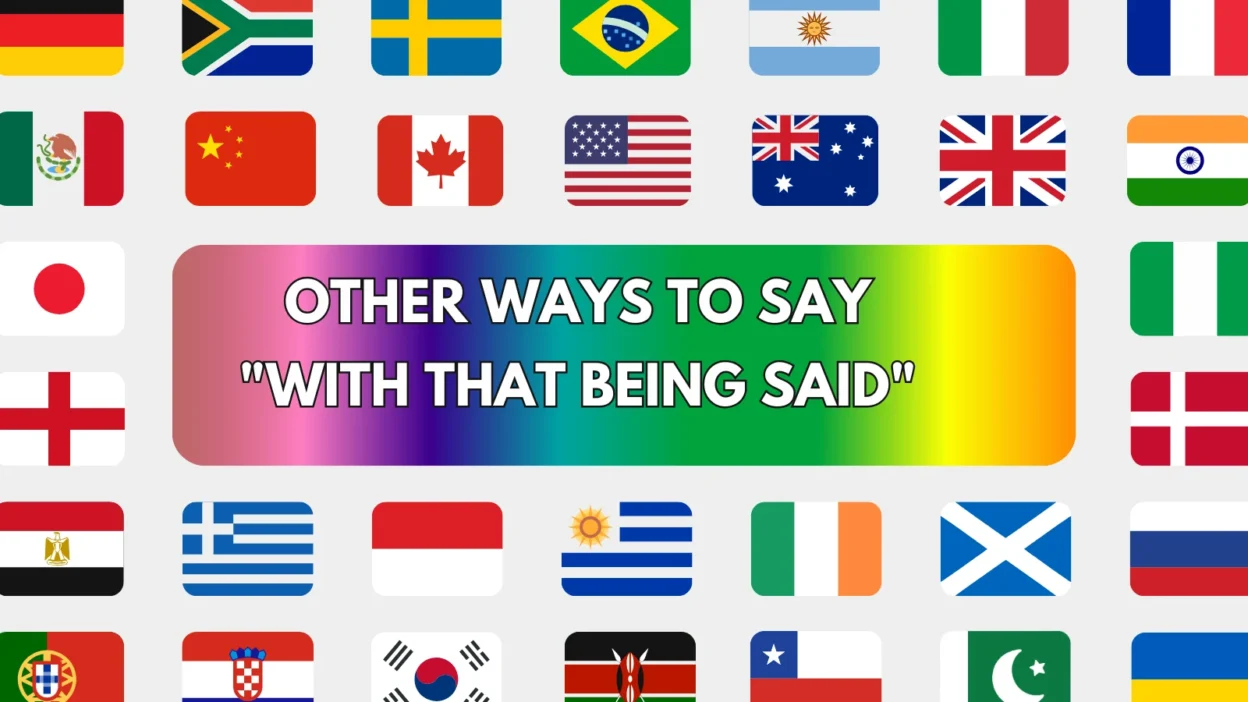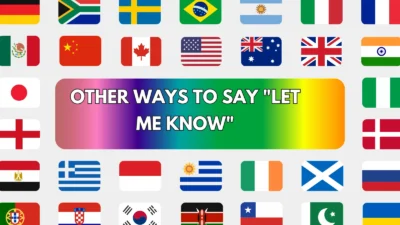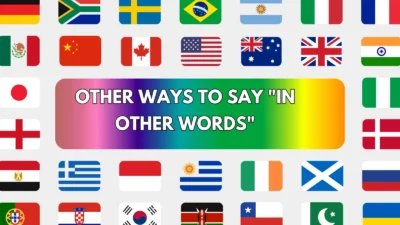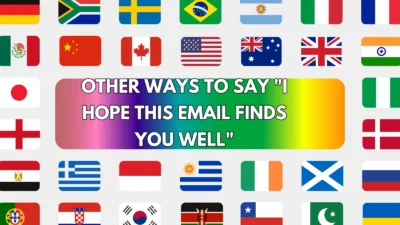The phrase “With that being said” is a common transition in speech and writing. It’s used to shift from one idea to another — especially when the second idea contrasts with or adds to the first. While it’s polite and clear, overusing it can make your writing feel repetitive or too scripted.
Fortunately, there are many smart and smooth alternatives you can use to keep your tone fresh, professional, and dynamic. Below are 25 different ways to say “With that being said,” complete with explanations, examples, and best contexts for each.
1. That Said
Meaning:
A shorter version of “with that being said” used to introduce a contrast.
Detailed Explanation:
It’s concise and sounds more natural in both writing and speech.
Scenario Example:
I think the idea is strong. That said, we’ll need more data to move forward.
Best Use:
Professional emails, meetings, essays.
Tone:
Professional, direct, neutral.
2. Having Said That
Meaning:
A smoother way to transition between two related but different points.
Detailed Explanation:
This phrase adds a conversational touch while maintaining clarity.
Scenario Example:
The results are promising. Having said that, we must stay cautious.
Best Use:
Formal writing, presentations, discussions.
Tone:
Polite, thoughtful, slightly formal.
3. Even So
Meaning:
Used to introduce an idea that slightly contradicts the previous one.
Detailed Explanation:
Great for expressing contrast while keeping a balanced tone.
Scenario Example:
It’s risky. Even so, I believe it’s worth trying.
Best Use:
Reports, articles, professional communication.
Tone:
Balanced, calm, neutral.
4. Nonetheless
Meaning:
Means “in spite of that” — it acknowledges something but moves forward.
Detailed Explanation:
Perfect for transitions where you respect a point but offer another.
Scenario Example:
He lacked experience. Nonetheless, he performed impressively.
Best Use:
Essays, academic papers, business writing.
Tone:
Formal, respectful, sophisticated.
5. However
Meaning:
A classic word for introducing a contrast or contradiction.
Detailed Explanation:
One of the most versatile transition words in formal writing.
Scenario Example:
We received several applications. However, few were fully qualified.
Best Use:
Business writing, formal reports, research.
Tone:
Formal, precise, objective.
6. Still
Meaning:
Adds contrast while keeping a conversational tone.
Detailed Explanation:
More casual than “however,” but just as effective in many settings.
Scenario Example:
I’m not a fan of spicy food. Still, I enjoyed the meal.
Best Use:
Conversations, informal writing, blogs.
Tone:
Casual, conversational, relaxed.
7. Nevertheless
Meaning:
Indicates that something happened despite the previous point.
Detailed Explanation:
A great way to show persistence or continuation despite a barrier.
Scenario Example:
The weather was awful. Nevertheless, the event went smoothly.
Best Use:
Essays, news writing, public speeches.
Tone:
Formal, steady, strong.
8. On the Other Hand
Meaning:
Introduces an opposing or alternative point of view.
Detailed Explanation:
Useful for comparing two sides of an argument or idea.
Scenario Example:
Online learning offers flexibility. On the other hand, it lacks personal interaction.
Best Use:
Analytical writing, debates, evaluations.
Tone:
Balanced, structured, academic.
9. At the Same Time
Meaning:
Shows that two seemingly different things can be true together.
Detailed Explanation:
Helps maintain nuance and complexity in your argument.
Scenario Example:
The product is expensive. At the same time, it’s built to last.
Best Use:
Business reports, evaluations, essays.
Tone:
Professional, thoughtful, fair.
10. But Still
Meaning:
Casual way to acknowledge a contrast while supporting both ideas.
Detailed Explanation:
Adds informality and emphasis to a contrasting statement.
Scenario Example:
It’s a long drive. But still, it’s totally worth it.
Best Use:
Personal writing, conversations, informal communication.
Tone:
Casual, honest, conversational.
11. Be That as It May
Meaning:
Acknowledges a point but indicates that it doesn’t change your main view.
Detailed Explanation:
A traditional phrase that sounds formal and slightly poetic.
Scenario Example:
He’s new to the field. Be that as it may, his insight is valuable.
Best Use:
Formal writing, opinion pieces.
Tone:
Formal, literary, diplomatic.
12. That Being the Case
Meaning:
Used when one fact leads naturally to another conclusion.
Detailed Explanation:
Adds logical flow, especially in analytical or persuasive writing.
Scenario Example:
The team is short-staffed. That being the case, we’ll postpone the launch.
Best Use:
Reports, strategic discussions.
Tone:
Professional, logical, firm.
13. Even Though That’s True
Meaning:
Admits the first idea is valid but introduces a counterpoint.
Detailed Explanation:
Helpful in respectful arguments or discussions.
Scenario Example:
Even though that’s true, we still need to address the risks.
Best Use:
Team meetings, debates, emails.
Tone:
Balanced, respectful, persuasive.
14. All Things Considered
Meaning:
Acknowledges the whole situation before making a point.
Detailed Explanation:
Used to wrap up thoughts while introducing a concluding contrast.
Scenario Example:
All things considered, extending the deadline might be best.
Best Use:
Summaries, decision-making, reports.
Tone:
Professional, evaluative, fair.
15. Then Again
Meaning:
Introduces a new thought or reconsideration.
Detailed Explanation:
It suggests that you’re rethinking or adjusting your point.
Scenario Example:
I thought it would be easy. Then again, nothing ever is.
Best Use:
Creative writing, informal discussion, reflection.
Tone:
Casual, thoughtful, open-minded.
16. With That in Mind
Meaning:
Means “considering that,” and prepares the reader for a conclusion.
Detailed Explanation:
Great for showing cause-and-effect or guiding next steps.
Scenario Example:
With that in mind, let’s revise our timeline.
Best Use:
Emails, instructions, summaries.
Tone:
Thoughtful, instructive, transitional.
17. Even Though
Meaning:
Shows contradiction between two ideas.
Detailed Explanation:
Often used to show that one factor doesn’t stop another from being true.
Scenario Example:
Even though the budget is tight, we can make it work.
Best Use:
Personal writing, formal and informal communication.
Tone:
Neutral, direct, honest.
18. In Light of That
Meaning:
Means “considering that,” or “because of that situation.”
Detailed Explanation:
Useful for transitioning based on something just mentioned.
Scenario Example:
In light of that, we’ll need to reassess our plan.
Best Use:
Professional communication, announcements.
Tone:
Formal, logical, measured.
19. Regardless
Meaning:
Shows that despite a previous point, your stance or action remains the same.
Detailed Explanation:
Strong and assertive, this keeps the focus on your main point.
Scenario Example:
Regardless, we must continue with the launch date.
Best Use:
Persuasive writing, leadership communication.
Tone:
Confident, firm, assertive.
20. In Any Case
Meaning:
Indicates continuation, regardless of what’s just been said.
Detailed Explanation:
Used to move forward in a conversation or writing.
Scenario Example:
In any case, let’s prepare the report by Friday.
Best Use:
Informal meetings, casual writing.
Tone:
Neutral, relaxed, forward-moving.
21. Either Way
Meaning:
Shows that two possible outcomes lead to the same result.
Detailed Explanation:
Helps show flexibility while still guiding direction.
Scenario Example:
Either way, we’ll need final approval by Monday.
Best Use:
Discussions, casual reports.
Tone:
Casual, decisive, practical.
22. In That Case
Meaning:
Responds to a condition or idea that’s just been stated.
Detailed Explanation:
Helps you pivot or decide what to do based on earlier context.
Scenario Example:
In that case, we’ll cancel the order.
Best Use:
Support emails, decision-making.
Tone:
Logical, practical, neutral.
23. In Turn
Meaning:
Indicates that one result causes another, sequentially.
Detailed Explanation:
Great for flow in analysis, essays, or cause-effect reasoning.
Scenario Example:
The delay caused budget issues, which in turn affected development.
Best Use:
Reports, academic writing, logical explanations.
Tone:
Analytical, structured, informative.
24. Following That
Meaning:
Used to smoothly transition to a related topic or action.
Detailed Explanation:
It’s a chronological or logical connector.
Scenario Example:
Following that, we’ll review the Q4 report.
Best Use:
Business writing, planning emails.
Tone:
Professional, structured, sequential.
25. To Move Forward
Meaning:
Used when transitioning from discussion to action.
Detailed Explanation:
This shifts the focus to solution or next steps.
Scenario Example:
To move forward, we need clarity from the vendor.
Best Use:
Action plans, meetings, decisions.
Tone:
Forward-thinking, confident, action-driven.
Conclusion
The phrase “With that being said” is helpful — but using it too often can make your writing predictable. By switching it up with these 25 powerful alternatives, you can express contrast, transition smoothly, or clarify your message with variety, style, and professionalism.




